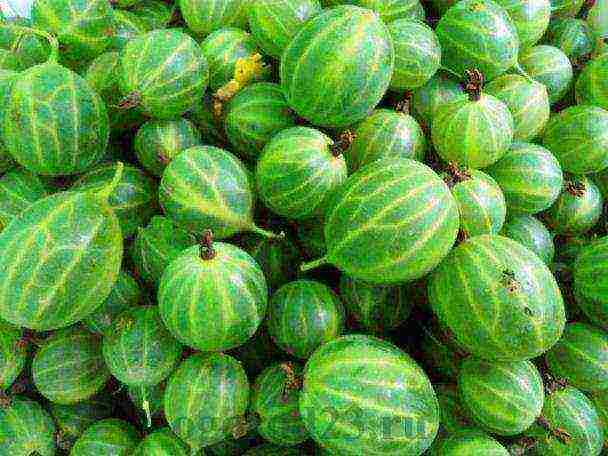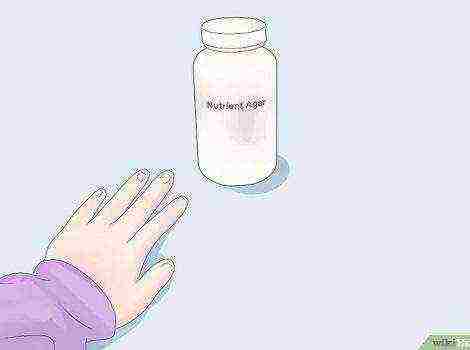Content
- 1 Description of the bushes
- 2 Gooseberry varieties
- 3 When to plant gooseberries
- 4 Planting gooseberries in autumn
- 5 Spring care
- 6 Autumn care
- 7 Top dressing gooseberries
- 8 Gooseberries: planting and care, pruning. What year does it bear fruit
- 9 Gooseberries: planting and care, propagation by cuttings
- 10 Gooseberry without thorns
- 11 Gooseberry diseases
- 12 Site requirements
- 13 Sapling selection
- 14 Landing subtleties
- 15 Features of tillage
- 16 Watering and feeding
- 17 Pruning rules
Gooseberries, planting and caring for which will be discussed in this article, belongs to the genus of currants and appeared in North Africa, as well as in Western Europe. In the wild, this plant can also be found in the Caucasus and North America. The gooseberry was first described by Ruel in 1536. And breeders from America managed to develop varieties that are not affected by powdery mildew.
Today this crop is grown in almost all countries of the world. Further, it will be considered what kind of gooseberry is, planting and care in the open field, as well as pests and diseases of this plant, measures to combat ailments and their prevention.
Description of the bushes
Gooseberry grows as a bush. Its height can reach one hundred and twenty centimeters. The bark of the plant is gray-brown in color and has thorns, the origin of which is leaf. And on cylindrical young shoots, thin thorns can be found. There is also a thornless gooseberry, planting and caring for which will be discussed in more detail below. The leaves of the plant reach a length of six centimeters and are round in shape. Flowers bloom in May and are reddish or greenish. Fruits are oval, smooth or covered with fine bristles. Usually their size reaches twelve millimeters, but there are specimens in which the berries grow up to forty millimeters.
Fruit ripening occurs in July or August. They can be green, yellow, red and even white in color. Berries are very healthy because they contain organic acids and salts of many metals. Gooseberry is a self-fertile crop. This means that even one bush in the garden will regularly bear fruit over the years.
Gooseberry varieties
Depending on what kind of gooseberry you grow, planting and care, reproduction and treatment of plants may differ. All varieties of the bush can be divided into two large groups. The first includes European representatives. This group is distinguished by a longer productive period and large berries. But it is more susceptible to attacks by various pests and diseases. The second group is hybrid varieties, or in other words, American-European. Representatives are much more resistant to various ailments. Gooseberry varieties may differ from each other even in the arrangement of thorns or their absence. The thornless species include eaglet, serenade, and tender.
Often in gardens you can find a hybrid plant that combines currants and gooseberries. Planting and caring for him is similar to other representatives of this genus. The name of this hybrid is yoshta. And he also enjoys considerable popularity.
When to plant gooseberries
If you decide to breed gooseberries on the site, planting and caring in the open field will require some knowledge and skills from you. You can plant a bush either in spring or in autumn, but only from late September to mid-October.
It is necessary to choose the right place for the plant, since its root system is quite long, gooseberries should not be planted in the lowlands. So you increase the risk of infection with fungal diseases.It is best to find a sufficiently lit place on a plain or hillock. Try to choose an area that is sheltered from the wind. Good results can be obtained by planting shrubs in sandy or clayey soil. It is only important not to forget that such soil requires frequent loosening.
There is one more thing to consider when choosing when to plant gooseberries. Planting and leaving in spring is not much different from autumn activities. Experienced gardeners are advised to choose the autumn time for planting. This is due to the fact that the bushes planted in October have much better growth and survival of the shoots.
Planting gooseberries in autumn
If you have decided what time of year to plant gooseberries (planting and leaving in the fall is more preferable), then we can move on to the theoretical part of this question.
Weeding the soil around the gooseberry bush is very inconvenient: all because of the large number of thorns. Therefore, the site is cleared of weeds in early autumn. For this, the area where the bushes are supposed to be planted is dug up. During this process, it is necessary to remove all weed roots from the soil with special care.
The next step after cleaning is preparation. The soil surface is leveled with a rake. All earth lumps break well. Two weeks before planting the plants, cube-shaped holes are dug. Each face of it should be half a meter. This is done in advance so that the land settles before planting the bushes. The fertile soil layer, which is located at the very beginning, is removed and mixed with fertilizer. If the soil is of clay type, then you need to add a bucket of river sand to the mixture.
Between two adjacent bushes, a distance of one to one and a half meters should be observed. But the distance between the rows of bushes should be at least three meters.
Choose one year old or two year old seedlings. Their root system is well developed and is about thirty centimeters long. The ground part of the plant should be formed by several strong shoots. Soak the roots in a fertilizer solution for twenty-four hours before planting. Prepare it by adding three or four tablespoons of nutrients to five liters of water.
It is necessary to place the seedling in the hole straight, giving it a slight slope. The roots are carefully and carefully straightened, making sure that the root collar is slightly below the soil level. The earth is covered in portions: each part is well compacted.
For one bush, a bucket of water is used for irrigation. After the soil is saturated with moisture, mulching is performed. For this, peat or humus is used. Then the shoots are cut, leaving five or six buds on each segment.
In order for you to eventually grow a beautiful, healthy, and most importantly - well-fruiting gooseberry, planting and care must be carried out in accordance with all the rules.
Spring care
When nature awakens from winter sleep, gooseberries also require some care. Planting and caring for this crop in the garden is not difficult for either experienced gardeners or beginners. The main thing is to comply with all agrotechnical rules. As soon as spring has come, before the snow has even melted, it is necessary to spray the gooseberry bushes with boiling water through a spray bottle. They do this in order to prevent damage to plants by pests and diseases.
In early May, you need to loosen the soil around each bush, deepening ten centimeters, and then mulch the soil. At the same time, feeding is done.
Gooseberry is one of those plants that are too acutely experiencing a lack of moisture in spring and summer. The best irrigation method is subsoil or drip. It is these options that make it possible to transport moisture directly to the root system, which is located at a depth of five to forty centimeters. Thus, the gooseberry is watered about five times during the growing season.Watering the plant overhead with cold water is not permissible.
If you decide to arrange gooseberries in rows in your garden, planting and caring in a set of activities will require the support of low hanging branches. To do this, at a height of about thirty centimeters, stretch marks are pulled between the rows or nets are used.
Autumn care
Autumn care for gooseberries consists in activities that prepare the bushes for wintering. First of all, this is top dressing. Fertilizer allows gooseberries to lay fruit buds by next year. Pruning is also done in the fall. If you cut the bushes in the springtime, it will weaken the plants, which will contribute to the occurrence of various ailments.
Top dressing gooseberries
Since the fruits on the gooseberry ripen for many years, it also absorbs nutrients from the ground in huge quantities. This leads to the need for annual fertilization. Moreover, they must be of a mineral and organic nature. In order for a healthy and prolific gooseberry to grow on your site, planting and care (you can see the photo in the sections of the article) must certainly include measures for the introduction of nutrients.
In the spring, the following mixture is prepared: superphosphate in the amount of fifty grams is added to half a bucket of humus, as well as ammonium sulfate and potassium sulfate. The last substances are twenty-five grams each. If the bush is very large and gives a bountiful harvest, then all components should be doubled.
Nutrients should be applied along the perimeter corresponding to the size of the crown. After fertilization, the soil is loosened. As soon as the gooseberry has faded and after another two weeks, the plant is fed with mullein solution. Mix one part of the mixture with five parts of water. Each bush should have at least five liters.
Gooseberries: planting and care, pruning. What year does it bear fruit
A gooseberry bush planted on the site begins to bear fruit after three years. The plant brings a crop for ten or even fifteen years.
The branching of the bush is strong enough, which does not contribute to a good harvest. This is why gooseberries should be trimmed. This can be done in the spring or fall. In general, the bush should have ten shoots of different age categories.
Spring pruning is done before the buds swell. It is necessary to ruthlessly remove all shoots that, after wintering, turned out to be weakened, dry, diseased or broken. In addition to all the listed candidates for removal, it is necessary to cut off the shoots near the roots and the weakened ends of the branches. All this must be done before the plant awakens, and it happens very early. If you are late with pruning, you will do a lot of harm. Based on this, it becomes clear why experienced gardeners prefer to prune the bushes in the fall. This way you can less injure the gooseberry. Planting and maintenance (pruning) carried out in autumn allows the bushes to better adapt to winter and acquire frost resistance. And also practically negates possible damage.
Autumn pruning is performed annually. If this is not done, then by the third year the bushes thicken to such an extent that the fruits greatly lose their quality. Branches of five and seven years of age are the most valuable. Also branching of the first three orders. All others do not have good productivity. Shoots more than ten years old are black and removed to their very base. Also, do not forget that too long branches should also be shortened. After the pruning is completed, all cuts must be treated with garden varnish.
Gooseberries: planting and care, propagation by cuttings
This culture, like all other plants, needs reproduction. We discussed earlier in the article in what conditions gooseberries should grow. Planting and caring, reproduction and planting - all this requires certain knowledge and skills.Reproduction by cuttings is considered the most time consuming option. And the result is not always positive. Most often, this method is good for breeding American varieties. The blanks are made in October or even November. Choose annual shoots and cut off the tops with a length of 25 cm. They must be completely healthy, without any signs of malaise. All leaves should be completely trimmed and the sections treated with paraffin wax. This cutting is stored in the refrigerator or buried in the snow. As soon as spring comes, such blanks are buried to a depth of fifteen centimeters. If you plant several copies, then the distance between them should be at least twenty centimeters. When burying cuttings, it is important to follow one simple but mandatory rule. Two buds should be left above the surface of the soil, updating the cut, and four buds are located underground. The land around is compacted, watered and mulched using peat or humus.
You can also propagate gooseberries using cuttings. This is done as follows. Select the branch that is closest to the ground and make an incision on it. We dig a shallow hole in the soil, bend a branch with an incision to it and fix it using a wire bent in the form of a hairpin for this. Sprinkle it all with earth and water it well. As long as the growing season lasts, this place should be constantly humid. In the fall, roots will appear in this section. The next year, as soon as spring comes, the rooted seedling must be separated from the mother bush using a sharp pruner. Now all that remains is to transplant a young bush where it should grow constantly.
Gooseberry without thorns
Gooseberry varieties that are partially or completely devoid of thorns are becoming increasingly popular among gardeners. What is the difference between a gooseberry without thorns? Planting and caring for such plants have their own characteristics. These varieties love fertile soils that contain a large amount of humus. After planting, the bushes are cut in such a way that two to four buds remain above the ground on each shoot. The fruits ripen in the second year, and their number reaches one and a half kilograms of berries from one bush. Reproduction takes place by cuttings.
Thornless gooseberries, planting and caring for which require a lot of attention, needs timely complementary feeding. In the spring (from late March to mid-April, as well as from late May to early June), ammonium nitrate or urea is added to the soil. In autumn, in the first half, organic fertilizers are used. And three years after planting, potassium salt and superphosphate are added to the soil annually in autumn. In hot weather, mandatory watering is required.
Self-fertility of this variety is low. Experienced gardeners recommend planting several bushes at a distance of one meter from each other for pollination.
It is also necessary to periodically spray the plants to prevent the invasion of pests and to avoid damage by powdery mildew. Twice a season they are sprayed with "Karatan" or "Topaz". And during the period when leaves are blooming - with one of the insecticides, for example, "Novaktion".
Gooseberry diseases
Powdery mildew is considered one of the most dangerous gooseberry diseases. Its other name is spherotek. This disease can destroy the entire crop overnight. And if the disease is not treated, then in a few years the end of the whole plant will come. The most dangerous time in this respect is when the weather is warm and humid. The gooseberry is covered with a loose bloom of white, which appears on the leaves, shoots and set fruits. Later, this plaque transforms into a crust that has a brown tint. The shoots under it bend and dry out, the leaves break, and the fruits do not ripen and crumble to the ground.To prevent the disease with powdery mildew, it is necessary to treat the gooseberries before they bloom with a solution of a preparation containing HOM copper. Forty grams of the drug is used for ten liters of water.
Of the other ailments of the gooseberry, anthracosis, mosaic and goblet rust are most common.
Mosaic refers to diseases of a viral nature. It is impossible to rid the plant of it. If the affected bushes were noticed, then they should be immediately dug up and put on fire. The rest can be healed. For this, the plant is treated with "Nitrafen" or copper sulfate. Spraying is carried out two times: first before bud break, and then ten days after the harvest is harvested. To prevent such diseases, it is necessary to remove all last year's leaves from under the bushes in the spring, and also to prevent weeds from appearing in the garden.
We examined how to maintain a healthy gooseberry (planting and care), diseases, as well as ways to prevent them. Now let's talk about pests.
Of the pests, the most common are the shoot aphid and the gooseberry moth. The moth lays eggs in flowers. Caterpillars emerging from eggs eat fruits in all directions. And the shoot aphid, as a result of its vital activity, leads to curling of leaves and curvature of the shoots. The berries are crushed and fall off.
Of course, pests can be controlled using various insecticides. But it is better to carry out preventive measures. Immediately after the snow melts, cover the soil under the bushes with dense material. Sprinkle the edges of the canvas with earth. Then the moths will not be able to crawl out of the ground. After the gooseberry has faded, the material can be removed. In the fall, hilling of the bushes should be carried out. They do it to a height of about ten centimeters. If you notice fallen berries, and even with caterpillars, then it is better to pick them right away. When the plant has faded, treat it with Lepidocide or another similar agent.
In this article, the gooseberry plant, which is so popular in our gardens, was considered, planting and caring for it, as well as methods of reproduction and prevention of its diseases. Having studied all the simple rules for growing this crop and consistently applying them in practice, you will get beautiful healthy bushes that bring a bountiful harvest of delicious berries for many years. And also in winter you will delight yourself, your friends and loved ones with aromatic gooseberry jam.
In the list of fruit shrubs, especially loved by summer residents, one of the first places is taken by gooseberries: planting and caring for it is not difficult, and many delicious berries ripen. He is also a long-liver. With the right approach to cultivation, the bushes will delight with a generous harvest for decades - from 20 to 40 years.

Site requirements
If there is no experience in growing a shrub, the first step is to figure out how to plant a gooseberry correctly. Best of all, the culture will develop in a spacious, open sun and well-ventilated area, but protected from drafts. The lack of light will not affect the growth of the bushes, but shading will have a bad effect on their yield. There are few berries on them, they will be small, and their ripening will be uneven.
Gooseberry belongs to unpretentious crops, it is successfully grown on almost all soils. The main thing is to regularly enrich the soil with organic fertilizers. This is especially important for European shrub varieties.
The rules for preparing the soil for gooseberries are simple.
- If the soil on the site is heavy, with a large admixture of clay, it is diluted with sand and humus (1 bucket of both per 1 m² of surface). The latter can be replaced with any other organic matter.
- For light and poor soil, regular application of the same amount of organic fertilizers will be required, but it will periodically need to be mixed with clay as well.
- Peat soil is enriched every year with 2 types of fertilizers - organic and mineral, containing a lot of phosphorus and potassium. Sand must be added to it. Experienced gardeners recommend adding sphagnum moss to the soil. It will help the soil stay moist and fertile for longer and will disinfect it. Before being placed in the ground, the moss is prepared by soaking it in a bucket of water in which 10 tbsp. l urea.
- Sour soil for growing gooseberries will not be a hindrance. But if the pH is less than 5.5, liming of the soil is carried out. They do this in advance - in the fall during the digging of the site, and even better - 2 years before the gooseberry is planted.
Advice
Light soils contain little magnesium, which is necessary for the development of shrubs. To reduce the acidity of the soil and at the same time make up for the lack of this element, dolomite flour or gypsum is added to the site before planting the gooseberry. You can scatter wood ash over it.
Damp, swampy soils, lowlands and places prone to flooding are not suitable for growing shrubs. Under such conditions, rot often affects its root collar, and the gooseberry dies. It is important to consider when planting and the level of groundwater. The distance to them must be at least 1.5 m.
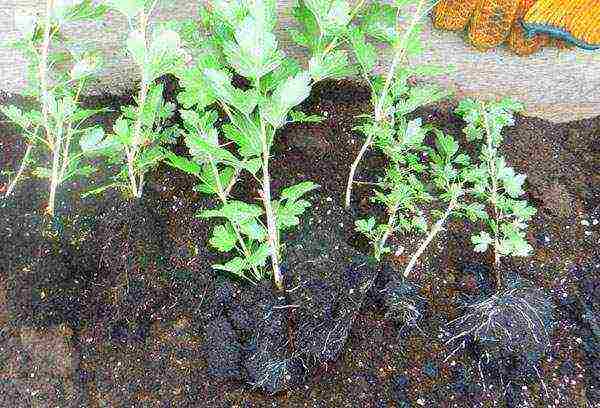
Sapling selection
The answer to the question of how to plant a gooseberry correctly is quite simple. If the ideal place for the shrub on the site is found, and the soil is prepared, they proceed to an equally important stage - the choice of seedlings. They are examined, rejecting those affected by pests and diseases, as well as those with mechanical damage and dry. Bushes take root well in a new place at the age of 2 years. It is better to buy from them those whose root system is open. This makes it easier to choose a quality seedling.
It is distinguished by the presence of 2-3 strong 25-centimeter shoots and developed roots, the length of which is at least 20-25 cm. The buds in the sinuses are not dissolved. And the roots are already completely woody and have acquired a dark color. Particular attention should be paid to the tops of the gooseberry shoots, they must be healthy and strong. They may have leaves, but in the correct seedling, most of the central stem and side branches are bare.
Having bought such a bush, you need to take care of its transportation. To protect the roots from drying out, they are placed in a damp burlap. Newspapers can be used instead. A plastic bag is put on top or a protective cover is wrapped with a film. The final step is to securely fasten the resulting structure with a rope.
Potted seedlings can be purchased at any age. It is optimal if the length of their well-leafy shoots reaches 40-50 cm and they have numerous white roots. It is important to check the firmness of the planting of young gooseberries. Its roots should tightly braid with an earthen lump, without going to the surface and not growing through the bottom of the container, and the bush itself should not be shaken out of it. Such seedlings in the fall can be placed in the ground not immediately, but after 2-3 weeks. The main thing is to regularly water the plant in a pot, preventing the soil from drying out. Be sure to moisturize it before transporting the shrub.

Landing subtleties
Gooseberry planting is practiced in spring and autumn. Professionals advise to postpone the procedure to a later time. When disembarking early, it is difficult to be on time. You need to get into a short time interval, when the soil has already thawed, and the buds on the plant have not yet swollen. If they have already woken up, and the soil has dried out, the shrub is harder to take root in a new place.
There are no such difficulties in autumn. If you plant 1-1.5 months before the first frost (in the middle lane, this is the period from the last decade of September to mid-October), new roots will form in the gooseberry, and it will easily endure the winter. At the initial stages of development, it is important for a shrub to get a lot of moisture. This is another advantage of the autumn planting.In the spring, when it starts to grow, the soil moist after the snow melts will be the key to its intensive development.
Advice
When digging a site, it is important to select the roots of weeds from the ground, paying special attention to wheatgrass and sow thistle. Otherwise, they will quickly grow, depriving the bush of nutrients and moisture, and it will be difficult to weed them out from under the spreading bush, the branches of which are covered with sharp thorns.
The distance between adjacent bushes depends on the cultivar. For low-growing varieties of gooseberries, 1 m of free space will be enough. Tall ones will need 2 times more space. Determining the depth of the planting pit, they are guided by the age and size of the bushes. For several plants, it is best to dig a trench. If the seedlings are 1 or 2 years old, its depth is made equal to 0.5 m.For single bushes, holes are dug with a diameter of 40-50 cm.This is done in advance - in autumn or summer (1.5-2 months before placing the seedlings in the ground) ...
The soil is filled with fertilizers:
- rotted manure or compost (10 kg for each bush);
- wood ash (100 g each);
- double superphosphate (50 g);
- potassium sulfide (40 kg).
Planting gooseberries includes several mandatory steps. They start with a close examination of the future bush. If there are damaged or dry areas on its roots or branches, they are removed. The tops of the shoots are cut off, leaving no more than 5 buds on them. In order for the bush to take root faster, its underground part is dipped into a solution of a root growth stimulator. At the bottom of the pit, a mound is poured into fertile soil. Having installed a seedling on it, gently straighten its roots and gradually cover the hole with earth, not forgetting to compact it so that voids do not form.
It is not necessary to cover the root collar of the shrub with soil, the optimal depth is 3-5 cm. Having planted a young gooseberry, it is watered abundantly, and the soil under it is mulched. It is best to use peat, straw or humus for the procedure, but dry soil can also be dispensed with. 3-4 days will pass, and watering and mulching is carried out again.
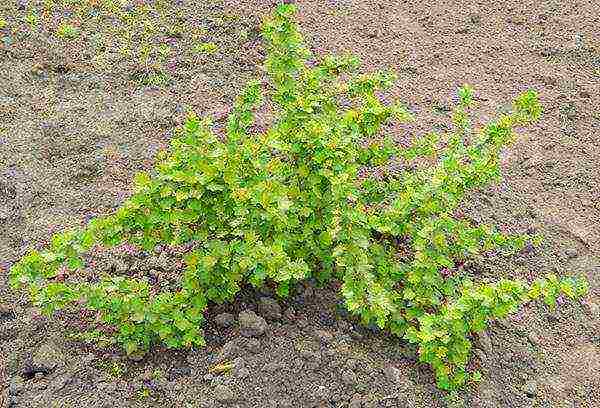
Features of tillage
Growing gooseberries on a personal plot will not bring much trouble. For the active development and fruiting of the shrub, the soil under it must be regularly loosened or dug up. The method of treatment and the depth of impact are selected based on the structure of the soil. If the land on the site is dense and heavy, it is better to dig it up. Light, porous soil can be loosened slightly with a garden fork.
The procedure is carried out carefully. Gooseberry roots are located almost at the very surface of the soil, and they are easy to damage. The soil, which is located directly under the crown of the plant, is loosened shallowly - only 6-7 cm, and between the bushes - by 15 cm. In the fall, before the procedure, fertilizers can be scattered over the soil surface. During loosening, they are embedded in the soil. On the eve of winter, the plants are slightly huddled, and in the spring they carefully rake the ground from their trunk with a pitchfork. Loosening is carried out quite often - 5-6 times per season.
Gooseberry is a rare cleanliness. Its bushes do not tolerate the neighborhood of weeds. To collect a high yield from them, you will have to devote a lot of time to weeding. In no case should it be allowed to overgrow the landings. Due to the accumulation of weeds in the soil, excess moisture is created, which can provoke the development of many dangerous diseases.
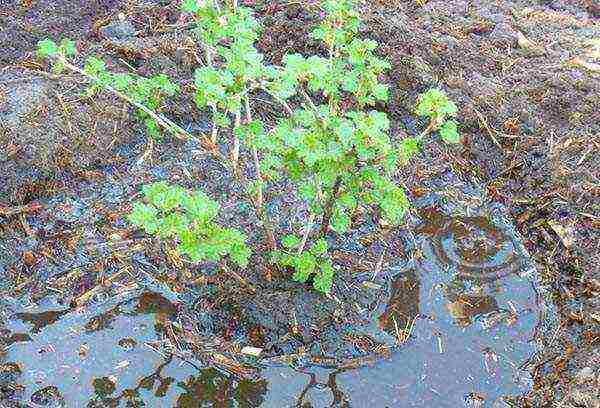
Watering and feeding
High yields greatly weaken the shrub. Therefore, during the season, it needs to be fed abundantly. Nutrient formulations are added twice. The first feeding is carried out when the gooseberry has faded. It stimulates the development of its shoots and formed ovaries.
The second time, the shrub is fertilized when the berries have already been collected from it. At this stage of the plant's life cycle, top dressing will guarantee a future harvest. In the fall, flower buds will be laid on its branches. Their number directly depends on the nutrients received by the shrub.
In dry summers, gooseberries will have to be watered regularly. You can start the next procedure if the soil is already dry. Water is poured under the root, carefully making sure that it does not fall on the leaves of the bush. If this happens, the gooseberries can get sick. For this reason, such a widespread irrigation method as sprinkling is not suitable for him. Not only excess moisture is harmful to the shrub, but also its lack. In spring, it should not be allowed during the period of active growth of gooseberries and the formation of ovaries, and in summer, special attention should be paid to watering 2 weeks before picking berries.

Pruning rules
To keep the bushes healthy and attractive, and the berries to be large, gooseberries are pruned. While the plants are very young (at the age of 1-3 years), its goal is to form their base. In the spring, the perennial shoots that make up the skeleton of the bush are left only ½ of the length. The root growth of the gooseberry is removed almost completely. At the 4th year of life and beyond the age, pruning is carried out to thin out the bush. Strong and healthy shoots do not touch. And it is better to get rid of the weak, dry, injured, affected by diseases or pests, beaten by frost and directed into the bush.
Advice
The peak fruiting of gooseberry branches occurs at the age of 3-6 years. Therefore, when pruning, you do not need to feel sorry for the old shoots - you still cannot wait for a generous harvest from them.
The formation of a bush begins in the fall, when it sheds its leaves, or in the spring, while its buds are still dormant. Many summer residents also practice summer pruning, which increases the quality of the crop. The gooseberry shoots are shortened when ovaries appear on them, cutting off their upper part so that 5-7 leaves remain on the branches. After this treatment, the berries on the bush are larger.
Northern grapes - this is what the people call gooseberries. This poetic comparison contains a tremulous love for the bush and a sincere admiration for it. Its advantages can be enumerated for a long time. It is unpretentious, high-yielding, frost-hardy, durable, easy to care for. It is not surprising that it has long become a familiar element of the country landscape.
Even beginners can handle the cultivation of a bush. The main thing is to familiarize yourself with the features of its agricultural technology before planting gooseberries. And then the matter remains small: choose the right site, prepare the soil and purchase high-quality seedlings.
 Each gardener strives to plant only the best varieties of berry plants on his site. Gooseberries are no exception. Considering the ease of care and reproduction, as well as the high taste characteristics of the berries and the presence of vitamins, many plant gooseberries. According to reviews, it is not enough to choose the right variety, you need to know the features of cultivation, protection against diseases, formation of shrubs and fertilization in order to get a bountiful harvest every year. Our photo tips will help you figure out how to do it right.
Each gardener strives to plant only the best varieties of berry plants on his site. Gooseberries are no exception. Considering the ease of care and reproduction, as well as the high taste characteristics of the berries and the presence of vitamins, many plant gooseberries. According to reviews, it is not enough to choose the right variety, you need to know the features of cultivation, protection against diseases, formation of shrubs and fertilization in order to get a bountiful harvest every year. Our photo tips will help you figure out how to do it right.
Varieties and varieties of gooseberries
By origin, gooseberry varieties are divided into groups:
- European... European varieties have large berries and high taste characteristics, but they are not resistant to diseases and difficult to reproduce.
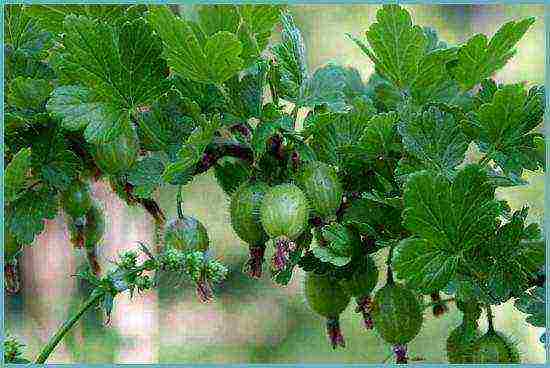
European group gooseberry
- American group has small berries, mediocre taste. Their advantage is resistance to fungal infections and ease of reproduction.

American group gooseberry
- Hybrid group it is resistant to powdery mildew, large berries with excellent taste.
A wide variety of varieties are presented by breeders, each of which has its own characteristics and characteristics. When choosing a variety for planting, take into account the climatic zone, since varieties intended for the south are unlikely to be able to fully exist in the northern region. For reproduction in large areas, varieties are chosen slightly spreading, upright.Breeders have bred many varieties without thorns, as well as non-thornless in the fruiting zone - they have separate thorns on lignified parts, and young branches without thorns.
The varieties that have high frost resistance, adapt well to weather changes, have powerful roots and are not afraid of the wind have proven themselves very well:
- Seedling shift;
- Russian yellow;
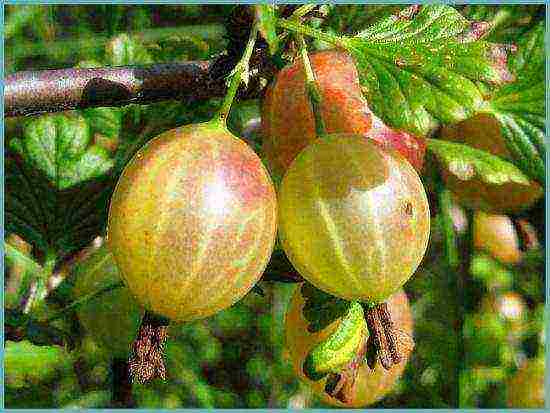
Variety Russian yellow
- Gingerbread man;
- Spring;
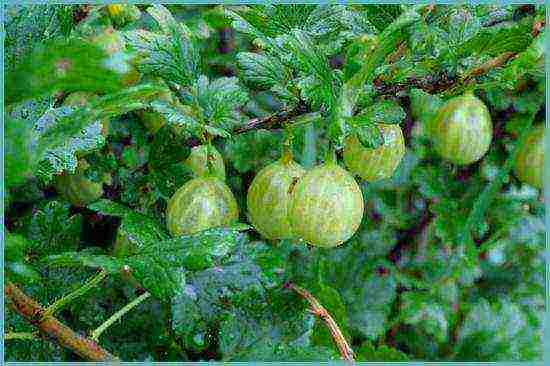
Rodnik variety
- Ural besshorny;
- Serenade.
Despite the presence of thornless varieties, thorny varieties continue to be grown (due to their large-fruited, high quality and excellent berry taste):
- Neslukhovsky;
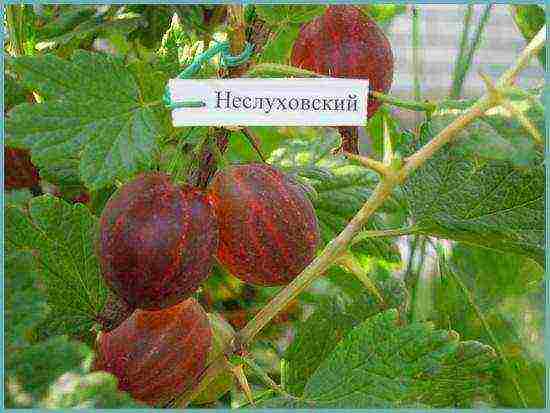
Variety Neslukhovsky
- Kamenyar;
- Carat;
- Malachite;
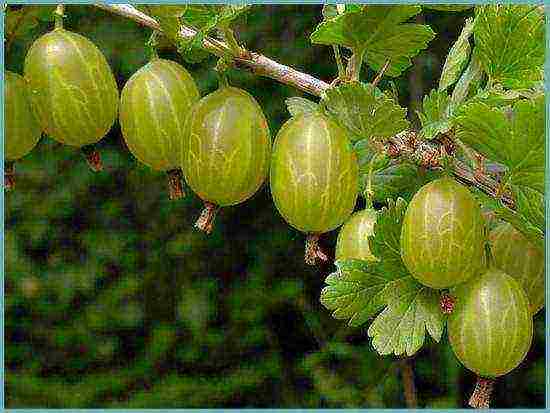
Malachite grade
- Ural emerald;
- Grushenka.
By crossing gooseberries and currants, we managed to get a hybrid called Yoshta. It is great for pinching and creating different shapes, has the growth strength of a small tree.
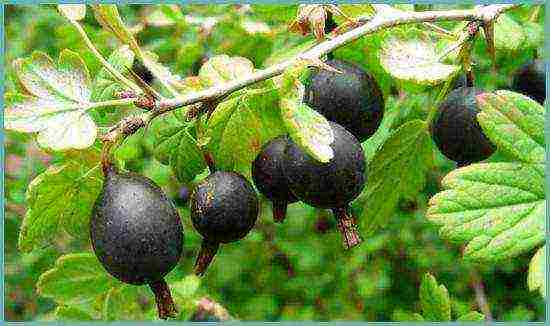
Yoshta hybrid
Some hybrid varieties:
- EMB;
- Chroma;
- Rext;
- Yokhilina.
Landing
Both autumn and spring planting can be carried out. The place is chosen illuminated, or with a slight partial shade. There are no special requirements for the soil, the main thing is that it is not acidic and not swampy. Rhizome perennials are removed from the site, and planting holes are prepared. On sandy soils, a couple of shovels of clay are brought to the bottom of the pit, and on clay soils - sand, humus and a handful of complex fertilizers are added from above. Sprinkle fertilizer with soil and plant.

Planting a gooseberry bush
They are planted obliquely, burying several buds into the ground. 4 buds are left above the soil surface, and the rest is removed with pruning shears. It is well watered and mulched after planting. A distance of 1.5 m is left between the bushes, twice as much between the rows. The distance may vary depending on the spreading of the variety.
Advice. Excess moisture can provoke rotting of the root collar and the death of the bush.
Care
Crop care, like any berry bushes, consists in watering, fertilizing and shaping.
It is very convenient to replace loosening with mulching so as not to injure the root system of the bush with the tool. Mulch suppresses weeds and retains moisture. Gooseberries especially need watering during flowering and ripening of berries.
A good effect is provided by the use of drip irrigation: water does not get on the foliage and does not provoke sunburn and fungal infections, besides, it is convenient to add fertilizers immediately to the irrigation container. Before the onset of frost, it is necessary to carry out water-charging irrigation if there is little rainfall in the fall.
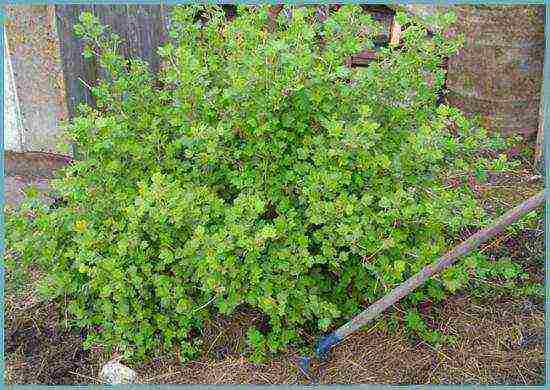
Very handy for gooseberry drip irrigation
Pruning is carried out every year in order to form a bush with the same number of branches of different ages. Branches over 6 years old are cut at soil level. In the spring, broken and frozen branches are removed to a healthy bud. All growing inward and thickening shoots are removed.
For decorative purposes, you can form a standard form or trellis.
Fertilization and feeding
Gooseberries, like all berry plants, are very demanding on nutrition. Without the introduction of organic fertilizers, it is difficult to count on a good harvest. Gooseberries are very responsive to potash and phosphate fertilization. They are brought in in the second half of the summer. During the opening of flower buds, nitrogen is introduced. Also, in the spring, add a bucket of compost under each bush.
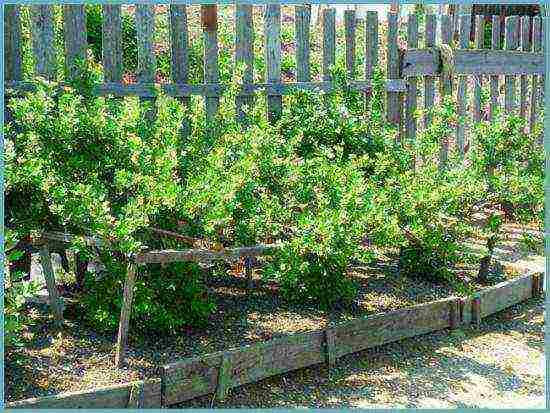
Create a support for the bush so that the branches do not lie on the ground
Fertilizers are applied along the perimeter of the crown of the bush. On light sandy soils, nutrients are washed out into deep horizons during irrigation and abundant precipitation faster than on loamy and clayey soils. Therefore, it is recommended to increase the fertilizer dose for such soils. After flowering, they are sprayed with chelated fertilizers on the leaf.
Advice. The device of enclosing supports at a height of 30 cm will keep the berries clean and facilitate the care of the bush.
Reproduction
Gooseberries are most often propagated by vegetative methods.Moreover, varieties of European origin are better propagated by layering, and hybrid varieties - by green and combined cuttings. Lignified cuttings root very poorly. Seeds are used by breeders to develop new varieties. With the seed method, you will have to wait for the berries for a very long time, and it is not clear what they will be, because the seed does not inherit maternal traits.

Scheme: propagation of gooseberries by layering
Layers. This method is the most reliable and effective. The branches of the shrub, in contact with the ground, form adventitious roots, which makes it possible for its rapid reproduction. Two-year-old branches are used, which are as inclined as possible towards the ground. In the spring, a groove is made under a branch in the ground and the shoot is placed in it, fixed with hairpins and sprinkled with soil on top. Hilling as vertical shoots grow and watered periodically. Weeds are removed. In the fall, the bushes are ready for transplanting.
Cuttings... This method is more complicated than the previous one. Most often it is used in nurseries. Not every variety is suitable for this method; only varieties of the American group give good results, for example, Kolobok, Smena, Yubileiny.

Gooseberry stalk
The material for spring cuttings is harvested in late autumn. They choose strong bushes without diseases and cut the cuttings by 30 cm, tear off the foliage, and dip the cut in paraffin so that the branch does not lose moisture. Store the workpieces in the refrigerator until spring. With the onset of heat, cuttings are planted in schools filled with nutritious soil. The bottom of the cut is renewed and planted so that 3 buds remain on the surface. Water and mulch.
Diseases and pests
Diseases and pests lead to a decrease in yield or even to the death of a plant. Sometimes it is enough to process with folk remedies; in advanced cases, you will have to use heavy artillery - fungicides.
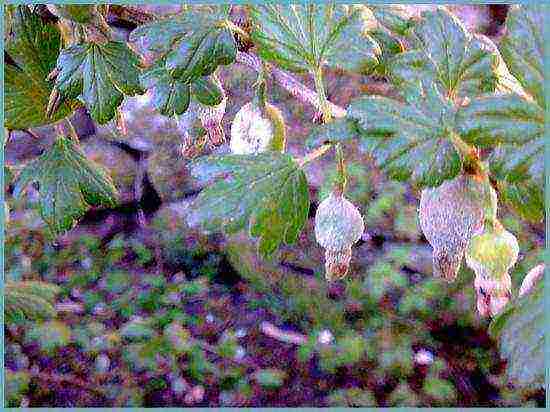
Powdery mildew
As a preventive measure, you can advise the observance of agricultural techniques, prevention of thickening of the bush, spring spraying with zircon, Bordeaux mixture or urea before the leaves bloom. Phosphorus fertilization is carried out in the fall. After leaf fall, the ground under the bushes is covered with a fresh layer of mulch, which will "bury" the infection. Gooseberries have common diseases with currants, as they belong to the same botanical genus.
- Powdery mildew.
- Septoria.
- Anthracnose.
- Mosaic.
- Gray rot.
- Rust.
Of the pests, it is worth noting such insects:
- Gallica.
- Glass-maker.
- Spider mite.
- Moth.
- Aphid.
- Fireball.
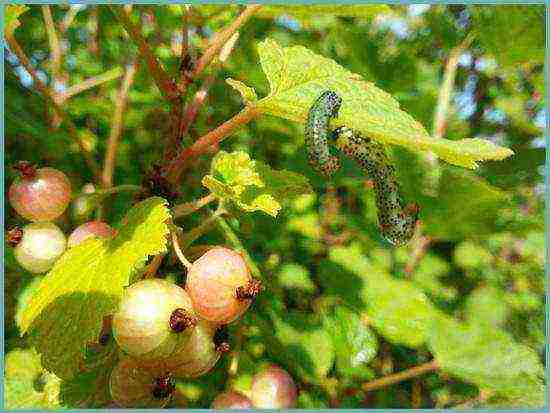
Gooseberry sawfly
The most "popular" disease is powdery mildew. The mycelium begins to sprout in the spring on all parts of the plant. The mycelium can be seen as a white bloom. Spores are carried by the wind from a diseased plant to a healthy one. A humid and warm spring promotes the rapid development of the disease. By the end of summer, the ripe mycelium looks like a felt with black dots. Gooseberry shoots stop growing, bend, berries crack and rot.
Old varieties are not resistant to this pathogen, the number of treatments for the disease reaches ten per season. Modern varieties are sprayed 2 - 3 times per season, and this is quite enough to maintain the health of the shrub and obtain high-quality berries. Therefore, choose varieties resistant to the pathogen, so as not to run from spring to summer on the berry with a sprayer.
How to grow gooseberries correctly: video
Varieties and types of gooseberries: photos
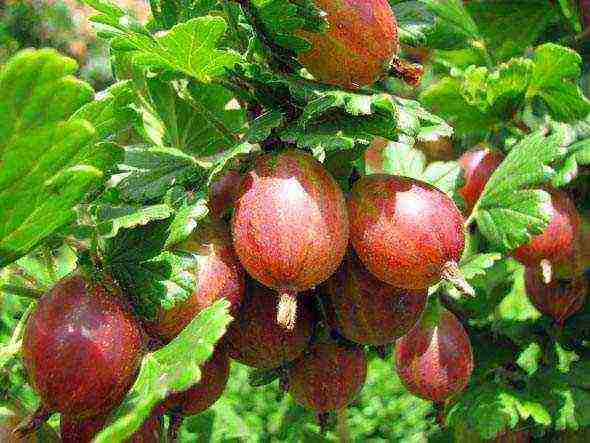
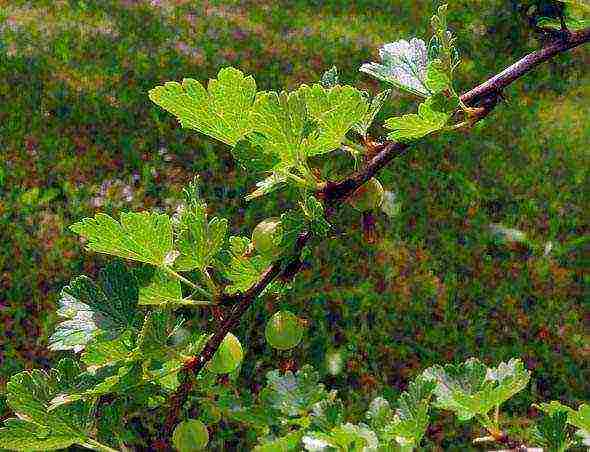
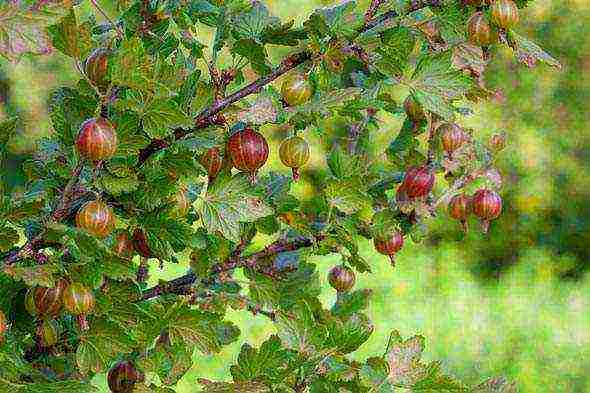
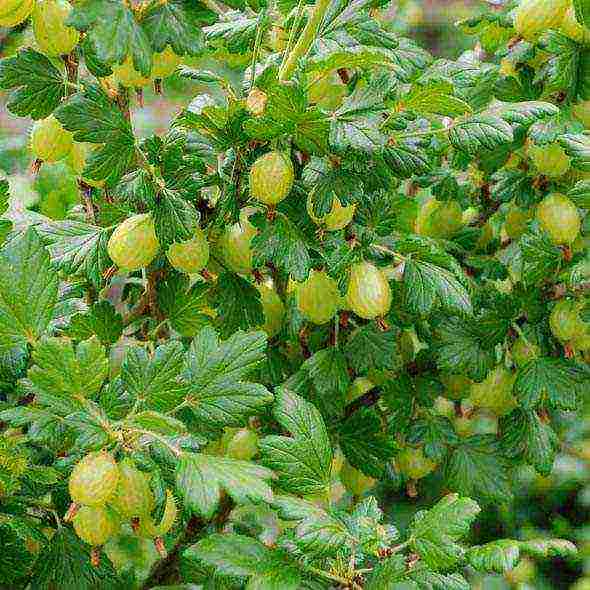

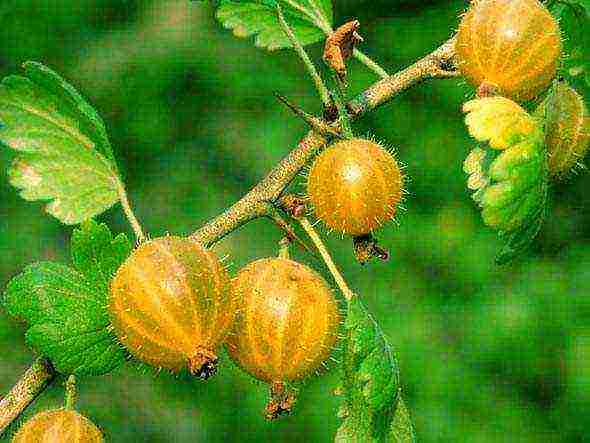
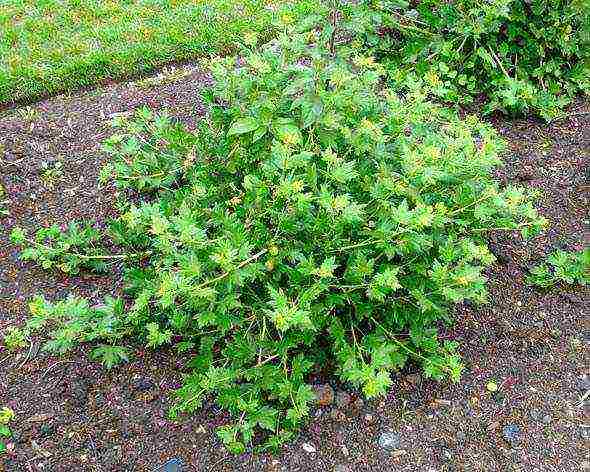
The topic of our conversation is gooseberries. Planting and caring for seedlings of this berry shrub, on the one hand, does not cause difficulties for gardeners, but on the other hand, it has its own characteristics, even subtleties.
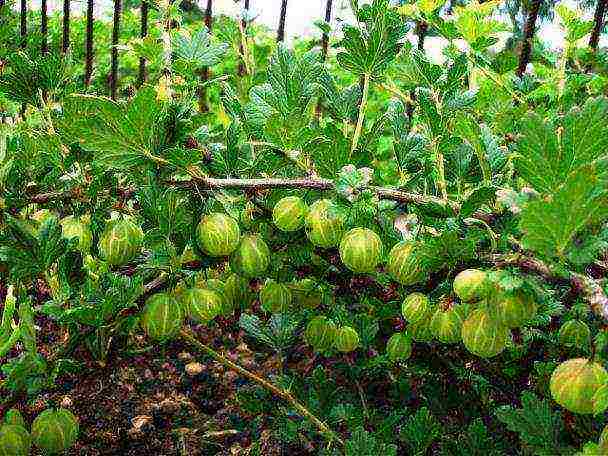 It turns out that at the beginning of the 20th century, in many European countries, gooseberries ranked first in terms of planting area! But ... with the spread of such a disease as powdery mildew, berry plantations began to decline catastrophically.It took more than half a century to develop gooseberry-resistant varieties in order to get high yields every year.
It turns out that at the beginning of the 20th century, in many European countries, gooseberries ranked first in terms of planting area! But ... with the spread of such a disease as powdery mildew, berry plantations began to decline catastrophically.It took more than half a century to develop gooseberry-resistant varieties in order to get high yields every year.
Now varieties that are resistant to many fungal diseases have been bred, so the popularity of gooseberries is growing not only on the plots of amateur gardeners, but also on industrial plantations. Moreover, thanks to the efforts of breeders, absolutely thornless varieties have already been obtained.
↑ back to contents ↑ Gooseberry planting site and site preparation
Gooseberry is a light-loving plant, so well-lit areas are chosen for it. He tolerates partial shade, but grows poorly in full shade, practically does not bear fruit.
Gooseberry prefers loam, sandy loam, black soil. Dislikes swampy, highly podzolic soil, heavy loams, sand. It grows best on soils, the acidity of which is close to neutral, - pH 6-6.5. If you plant a berry in an open place, you need to provide protection from summer dry winds, cold winter winds.
Having chosen a place for planting gooseberries, you first need to get rid of perennial weeds. To do this, the site is sprayed twice with continuous herbicides (roundup, hurricane, etc.).
Very good results are obtained by pre-planting sowing and plowing of green manure (rye, mustard, etc.). This technique helps to make the soil looser, more fertile. In addition, before planting, 6-10 kg / m2 (depending on the composition of the soil) organic fertilizers (humus, compost) are applied under continuous digging.
Another important technique is fumigation, that is, soil treatment with drugs that destroy diseases and pests. This procedure is not cheap, but it can significantly increase yields, as well as reduce the use of protective equipment.
↑ to the content ↑ The best dates for planting gooseberries
The optimal time is October, in the Kuban - from mid-October to the end of November. Previously, it is undesirable to plant gooseberries.
For a successful wintering, plants must accumulate a sufficient amount of plastic substances, and this is possible only at low positive temperatures, which fall just in October. During this period, the gooseberry will have time to take root before the onset of frost, and in the spring it will start to grow rapidly.
If the optimal deadlines are missed, it does not matter, this can be done later. I planted gooseberries even in winter windows, this did not affect the survival rate. Plants planted in spring may be inferior in development to those planted in autumn.
↑ back to contents ↑ Gooseberry - planting scheme
It all depends on the area of the berry, the processing scheme for row spacings. On personal plots, which are processed mainly by hand, the aisles are made no more than 2 m wide.
The distance between gooseberry plants in a row depends on the formation. If it is a powerful bush, consisting of 20 shoots, the distance between the plants is about 1.5-2 m (it depends on the growth vigor of the variety). With intensive technology, the distance in a row can be 60-70 cm, but then more frequent pruning and rationing of shoots will be needed (2-3 shoots are left annually and they are cut out not after the 6th, but after the 3rd fruiting; the bush consists of 8- 12 shoots).
↑ to the content ↑ How to buy gooseberry seedlings correctly
The quality of the planting material is very important. Gooseberry seedlings must be healthy, free from quarantine diseases and pests. Otherwise, it will be impossible to achieve generous fruiting. That is why it is best to buy seedlings from specialized nurseries or from reliable sellers.
Since most gooseberry varieties do not propagate well by cuttings, cuttings are most often offered. A quality seedling is considered to be a layer with one or more shoots at least 5 mm thick and 2-3 skeletal roots at least 15 cm long. When buying a seedling, you should make sure that it is alive. To do this, make a transverse cut of the root.If it is white or cream - the root is alive, and if it is gray, brown or black - it means that it has already died, you should not take such a gooseberry seedling.
Then you need to check if the kidneys are alive. To do this, the kidney is separated, kneaded with your fingers, it must be moist. It is also worth picking up the bark if a moist green layer underneath is a good sign. You can buy a seedling only if you are convinced that it is viable.
↑ back to contents ↑ How to plant gooseberries in the fall
We prepare a planting pit for the gooseberry with a size of 40 × 40 × 40 cm, add about 0.5 kg of complex mineral fertilizers, add 2-3 liters of wood ash. Mix everything thoroughly with the ground.
We add organic matter (1 bucket of rotted manure or compost) only if we plant gooseberries in the spring, so as not to attract bear, May beetle larvae and other "evil spirits" that can eat the entire root system during the winter. If necessary, in the fall we bring in organic matter for digging.
For better survival, a seedling with an open root system is soaked in water for 12-48 hours so that the plant is saturated with moisture. If you add growth and root formation stimulants to the water, gooseberry survival rate will increase many times. Before planting, remove the leaves from the seedling.
Pour 3-5 liters of water into the prepared planting pit. When it is absorbed, pour in the same amount, set the seedling in the hole obliquely and fill it with soil, deepening the root collar by 5-15 cm, so that additional roots are formed and shoots grow better. With this method, the possibility of rupture of small roots is excluded: the soil has the consistency of thick sour cream, it does not form voids, respectively, the roots are not injured during shrinkage. We fill the earth so that a hole with a depth of 5-15 cm remains. This will facilitate watering, fertilizing. After a day, we loosen the soil around the gooseberry, mulch the hole so that the soil does not begin to crack, tearing the roots.
It is better to huddle the seedling for the winter. In the spring we uncook it, that is, we shovel the earth from the bush, cut it off, leaving 2-3 buds above the soil level. Uncut seedlings winter better and grow more intensively in spring.
So we planted gooseberries. Planting and leaving is not difficult - now you know all the details.
Good luck to you!